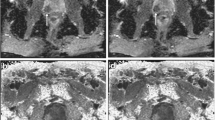Abstract
Purpose.
Diffusion is a physical process based on the random movement of water molecules, known as Brownian movement. Diffusion-weighted imaging (DWI) is a magnetic resonance imaging (MRI) technique that provides information on such biophysical properties of tissues as density, cell organisation and microstructure, which influence the diffusion of water molecules. The aim of this study was to evaluate the ability of MRI to obtain information on the diffusion of water molecules in normal and malignant prostate tissues.
Materials and methods.
Ten volunteers and 19 patients with prostate lesions diagnosed by transrectal ultrasound (TRUS) were enrolled in our study. Morphological imaging was obtained with T2-weighted turbo spin-echo (TSE) sequences with and without fat suppression [spectral presaturation with inversion recovery (SPIR)] and an axial dynamic T1-weighted SPIR fast-field echo (FFE) sequence during intravenous administration of contrast material. DWI was obtained with a high-spatial-resolution singleshot spin-echo echo planar imaging (EPI) inversion recovery (IR) sequence. The apparent diffusion coefficient (ADC) maps were analysed by positioning an 8-pixel region of interest (ROI) over different zones of the prostate, and the focal lesion when present. The tumour was confirmed by a TRUS-guided needle biopsy taken within 1 month of the MRI examination.
Results.
The mean ADC value of the central zones (1,512.07±124.85×10-3 mm2/s) was significantly lower than the mean ADC of the peripheral zones (1,984.11±226.23×10-3 mm2/s) (p<0.01). The mean ADC value of tumours (958.97±168.98×10-3 mm2/s) was significantly lower than the mean values of normal peripheral zones (p<0.01).
Conclusions.
Our preliminary results indicate that DWI is useful for characterising tissue in the different regions of the prostate gland and in distinguishing normal from cancerous tissues, given its ability to detect early changes in the structural organisation of prostate tissue.
Similar content being viewed by others
Author information
Authors and Affiliations
Corresponding author
Rights and permissions
About this article
Cite this article
Manenti, G., Squillaci, E., Di Roma, M. et al. In vivo measurement of the apparent diffusion coefficient in normal and malignant prostatic tissue using thin-slice echo-planar imaging. Radiol med 111, 1124–1133 (2006). https://doi.org/10.1007/s11547-006-0110-8
Received:
Accepted:
Published:
Issue Date:
DOI: https://doi.org/10.1007/s11547-006-0110-8




